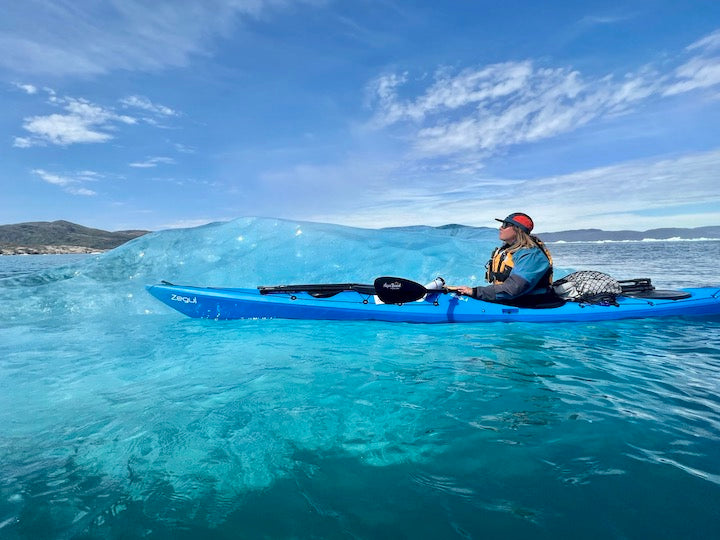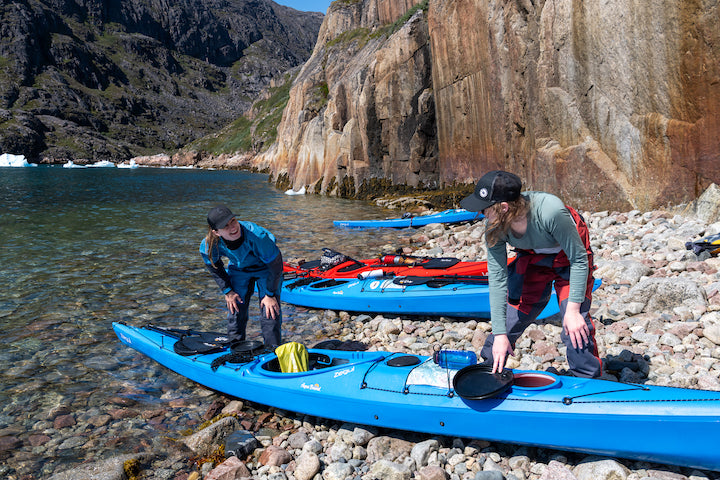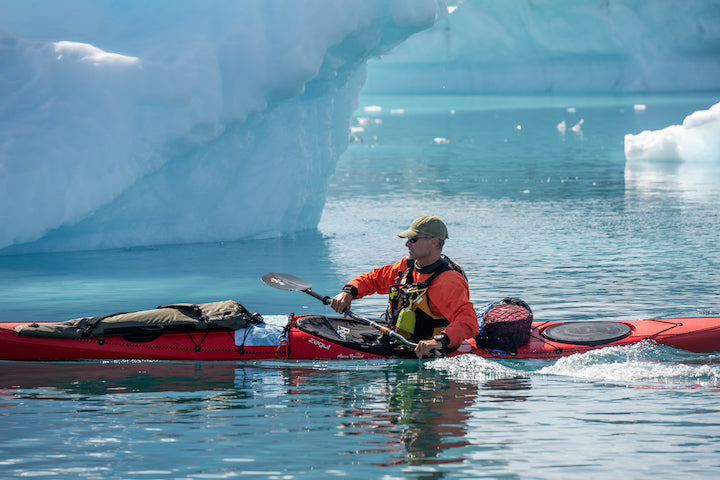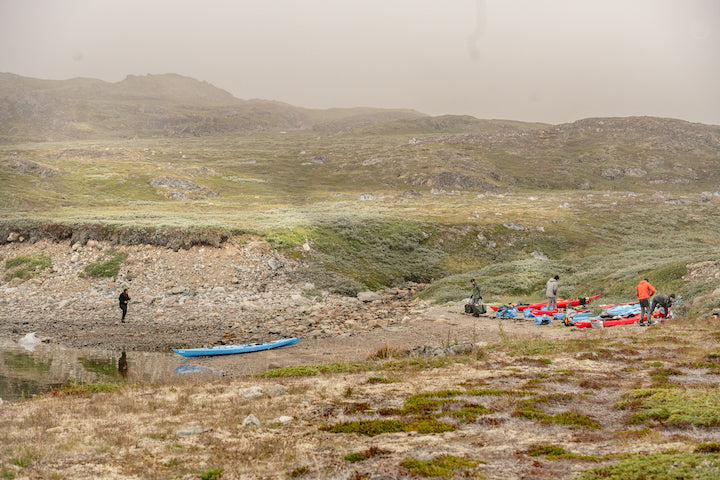“What I Packed for My Greenland Kayak Trip”
9-minute read
Aqua Bound Marketing Manager Kate Wright was one of six of our team members who embarked on a Greenland kayak trip in summer 2023. Here Kate talks about the challenges of packing for a multi-day trip like this—especially an international one.

Kate Wright kayaks next to a Greenland iceberg
If a multi-day kayak trip is on your bucket list, too, you’ll get some great pointers from Kate on topics like:
- How the destination’s climate impacted her gear choices
- How Greenland’s remoteness affected packing and traveling
- The differences in going with an outfitter/guide service vs on your own—including language challenges when going cross-cultural
- Kate’s specific packing choices and things she would’ve done differently
(NOTE: While Kate has had plenty of backcountry experience, including wilderness canoe and backpacking trips and front country kayak packing trips, this was her first remote kayak packing trip.)
AQUA BOUND: Give us the basic layout of your trip as far as length, time on water and logistics.
KATE: Our expedition spanned 11 days, with five of those dedicated to navigating the waters of Greenland by kayak. The logistical intricacies of reaching this remote destination were apparent from the outset.
Given the current limited access to Greenland, our journey required us to enter via Copenhagen, Denmark, or through Iceland. Recognizing the potential for travel disruptions, we factored in buffer days to accommodate any unforeseen delays, which came in handy.
As soon as we arrived at the airport, our plans encountered a hiccup as our departure flight was canceled, prompting a rearrangement of our itinerary. While some of our party proceeded to Copenhagen through Toronto but with a 24-hour delay, the rest of us rerouted via Iceland.
Future travelers to Greenland will likely encounter fewer logistical hurdles once the construction of the true international airport is completed. However, this convenience may come at the expense of the uncommercialized, remote charm that currently defines the region.
Beyond the travel days, we allotted additional time on either end of our expedition for preparation, debriefing with our guides, and getting to know the locals over a beer, resulting in a total Greenland immersion spanning seven days.
Venturing through South Greenland, our journey epitomized a true backcountry experience, with nightly campsite transitions offering an unparalleled exploration of fjords rarely explored since the time of the Vikings.

Kate in her tent in South Greenland
AB: In what ways did your packing differ for a trip with an outfitter/guide compared with one on your own?
KATE: Our experienced guides, Aqua Bound Ambassadors Laila Reigstad and Christian Harstad, provided us with a comprehensive packing list tailored to Greenland. This guidance proved invaluable, particularly given the unique challenges posed by the unfamiliar terrain and climate.
As none of us had prior experience in Greenland, having a detailed packing list not only assisted us in organizing our kayak gear but also ensured we were adequately prepared for the unknown.
One notable aspect of our preparation was the scarcity of readily available information regarding the environmental conditions we would encounter, including temperature variations and the specifics of kayak storage. Therefore, the guidance provided by our guides played a crucial role in mitigating potential uncertainties.
Despite our guides’ excellent command of English, communication nuances occasionally posed challenges. Minor miscommunications happened through language and time zone barriers, such as whether paddling shoes and gloves would be provided, causing us to discover upon arrival that this was not the case.
Nonetheless, we adapted by using our own footwear, such as Crocs or Chacos, and thankfully, the weather conditions were milder than anticipated. While this discrepancy was resolved easily, it underscored the importance of clarifying expectations and logistics beforehand, particularly in cross-cultural settings.

All their gear had to be stowed inside the kayaks as they moved from place to place
AB: How did Greenland’s climate affect your gear choices?
KATE: Greenland's climate, even in the summer months, tends to be cool. While we prepared for daytime temperatures (Farenheit) in the 50s and nighttime temperatures in the 30s, we encountered unseasonable conditions, with daytime temperatures ranging from 60 to 80 degrees Fahrenheit and nighttime temperatures spanning from the 30s to 50s.
As someone accustomed to layering as a lifelong practice, I found the ability to adjust my clothing layers essential, particularly on the warmer days when shedding layers down to a T-shirt once off the water.
Given the fluctuating temperatures and the maritime environment, our gear choices were carefully selected to ensure versatility and adaptability. Breathable wool served as our go-to base layer, offering both insulation and moisture-wicking properties crucial for prolonged periods on the water and under drysuits.
We also prioritized high-quality mid and outer layers to shield us from rapid changes in temperature. Even during balmy 80-degree days, the temperature would drop in the evenings, necessitating an ability to quickly adapt.
Despite the chilly waters and presence of icebergs, our adventurous spirit prevailed, prompting us to pack bathing suits! Embracing our resilient Midwestern roots, we couldn't resist the one-in-a-lifetime opportunity to swim among the icebergs. My favorite photo of myself on the trip is me and the inflatable pink flamingo!

Kate in the pink flamingo
AB: How did your trip's remoteness affect your gear choices?
KATE: The remoteness of our trip underscored the importance of strategic gear choices from both a practical and logistical standpoint. While our guides carried Garmin InReach satellite communicators and offered us use, I opted to bring my own as well.
This decision proved invaluable, as my husband and I were in the midst of purchasing a house when I left for the trip and needed to communicate regarding the details of the sale.
We quickly realized the impact of differing baggage restrictions for the flights in and out of the country. Operating with smaller aircraft and unique airport protocols, we were compelled to plan our luggage arrangements to adhere to size and weight limitations.
The hefty ticket prices and baggage fees left no room for error, emphasizing the need for precision in packing to avoid substantial penalties.

Kate’s camera gear was worth the extra weight and space so she could get shots like this
Adding to these logistics was an emphasis on selecting versatile clothing items capable of serving multiple purposes and extended wear. Each garment had to be selected for its utility and adaptability, with careful consideration given to distinguishing between necessities and luxuries.
With limited access to supplementary gear options upon arrival, the importance of prioritizing essential items over indulgences became abundantly clear.
AB: Are there gear items you could've left behind? Or items you wish you had brought along?
KATE: My perspective on this question is very different from the rest of the crew. As the trip photographer, striking a balance between essential camera gear and personal necessities proved challenging, with weight restrictions dictating tough decisions.
While I prioritized camera equipment, there were moments when I felt the absence of items backup base layers and additional outerwear, especially during chilly nights in the tent.
In hindsight, I realize I overestimated the need for backup power banks, resulting in unnecessary weight and space consumption. Similarly, the inclusion of a tripod, though useful on occasion, could have been omitted to streamline packing.
I leveraged prior backcountry practice to optimize my packing. Understanding the importance of versatility and endurance in clothing choices, I prioritized practicality over variety, a decision informed by previous wilderness excursions.
One indulgence that proved immensely beneficial was a compact rechargeable sleeping pad inflator. Its weight and size were essentially unmentionable, but it became my favorite luxury, particularly after exhausting 13-hour paddling days when the strain of manually inflating a sleeping pad would have been a huge annoyance.

The crew took a couple of overland portages so they could kayak more of Greenland’s fjords—which meant they had to carry all their gear and the kayaks
Potentially the most noteworthy aspect of our gear considerations on arrival was the inclusion of extra cooking supplies and provisions to support us in preparing meals throughout the expedition.
While this added weight and bulk to our load, the experience of enjoying home-cooked hot meals amid the wilderness was unanimously cherished—Laila is a tremendous chef and made us all want to say goodbye to dehydrated meals forever.
Additionally, my decision to invest in an international cell phone plan proved invaluable, offering connectivity for the whole team during our travel days. We laughed when I had better service in Narsaq, Greenland than I do at company headquarters in Osceola, WI.
AB: Are outdoor adventure activities popular in Greenland for the native Greenlanders?
KATE: Greenland is where kayaking was invented, however people in Greenland don’t kayak anymore! Our guides shared that they were calling our kayaks “wanna-be” or fake kayaks because they were plastic instead of wood.
Our guides spend 5-6 week stretches there with new groups coming every week. In between groups, they would try to invite Narsaq residents to come and check out their kayaks and test them out.
Greenland is trying to grow its ecotourism culture, but so far it’s mostly Europeans guiding for hiking or glacier trips, or even boat trips, and a small bit of paddling. We didn’t see any other kayakers the entire time we were there—or even other humans, once we launched. It was my understanding that not many guiding permits are issued in this region.
West Greenland has a larger population and soon to be an international airport. I would expect to see an eco-tourism boost in the coming years.

Kate Wright, Aqua Bound’s Marketing Manager, in Greenland
* * * * *
A big thanks to Kate for her time, insights and photos! If you’d like to read up on more of our crew’s Greenland adventure, click here: Aqua Bound Goes to Greenland.
Do you have paddle questions our friendly Customer Service Team can help you with today? Contact them: 715-755-3405 • sales@aquabound.com
More for you...





